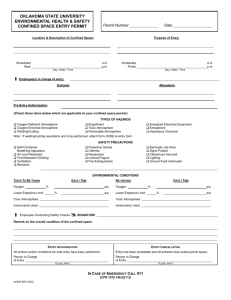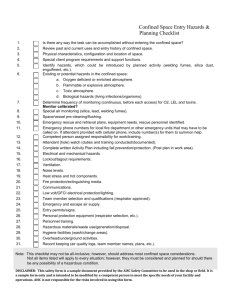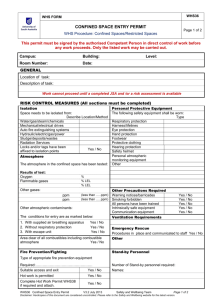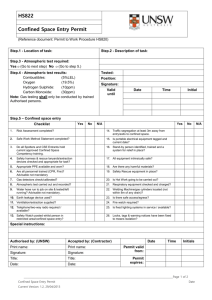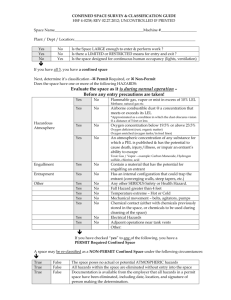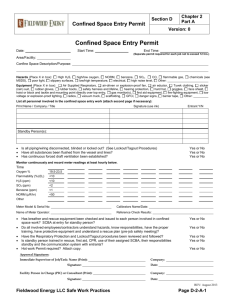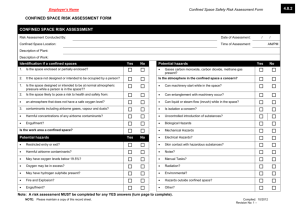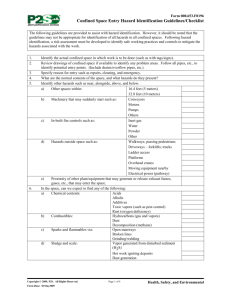confined space safety guidelines - E Light Safety, Training and
advertisement
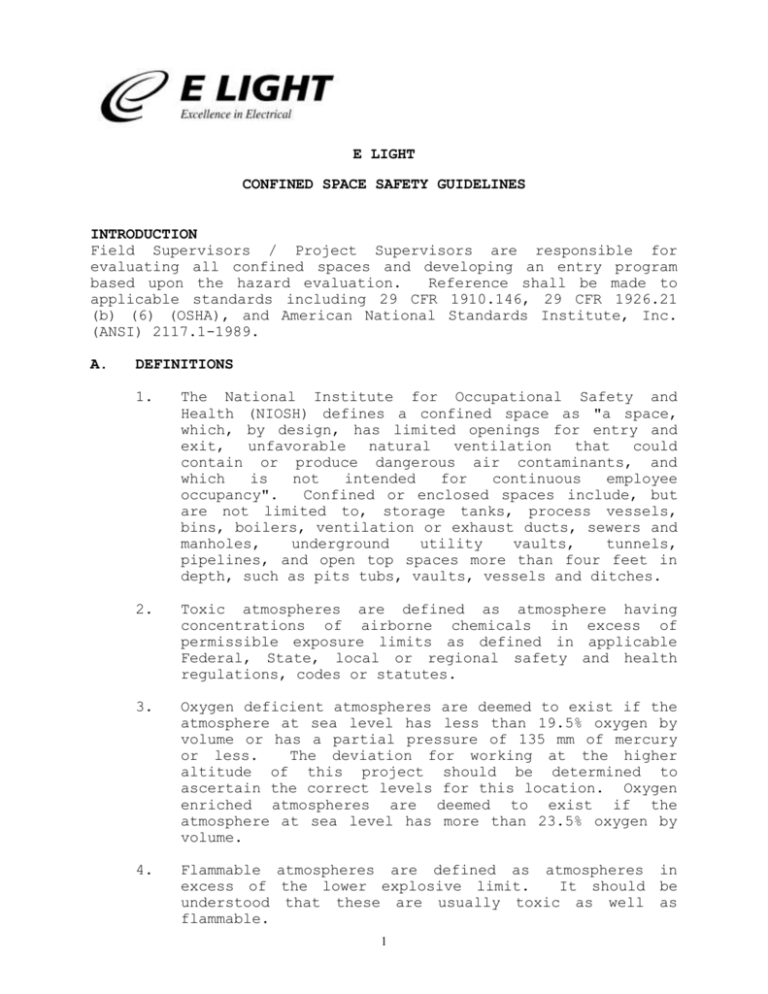
E LIGHT CONFINED SPACE SAFETY GUIDELINES INTRODUCTION Field Supervisors / Project Supervisors are responsible for evaluating all confined spaces and developing an entry program based upon the hazard evaluation. Reference shall be made to applicable standards including 29 CFR 1910.146, 29 CFR 1926.21 (b) (6) (OSHA), and American National Standards Institute, Inc. (ANSI) 2117.1-1989. A. DEFINITIONS 1. The National Institute for Occupational Safety and Health (NIOSH) defines a confined space as "a space, which, by design, has limited openings for entry and exit, unfavorable natural ventilation that could contain or produce dangerous air contaminants, and which is not intended for continuous employee occupancy". Confined or enclosed spaces include, but are not limited to, storage tanks, process vessels, bins, boilers, ventilation or exhaust ducts, sewers and manholes, underground utility vaults, tunnels, pipelines, and open top spaces more than four feet in depth, such as pits tubs, vaults, vessels and ditches. 2. Toxic atmospheres are defined as atmosphere having concentrations of airborne chemicals in excess of permissible exposure limits as defined in applicable Federal, State, local or regional safety and health regulations, codes or statutes. 3. Oxygen deficient atmospheres are deemed to exist if the atmosphere at sea level has less than 19.5% oxygen by volume or has a partial pressure of 135 mm of mercury or less. The deviation for working at the higher altitude of this project should be determined to ascertain the correct levels for this location. Oxygen enriched atmospheres are deemed to exist if the atmosphere at sea level has more than 23.5% oxygen by volume. 4. Flammable atmospheres are defined as atmospheres in excess of the lower explosive limit. It should be understood that these are usually toxic as well as flammable. 1 B. PRE-PLANNING AND EMPLOYEE TRAINING The Supervisor shall provide the necessary protection from the hazards, which may result from entry into a confined space. This includes, but is not limited to the implementation of procedures, training, and planning for entry into confined spaces which present a problem due to toxicity, flammability, oxygen deficiency or excess, mechanical, electrical, corrosive or temperature hazards. 1. E Light has developed and will enforce the written procedure which does include planning, general precautions procedures, testing and evaluation of hazards, ventilation requirements, personal protective equipment requirements, assignment of responsibilities, and emergency evacuation procedures. 2. For each job involving a confined space, Supervisors are competent in the evaluation of hazards, and associated precautions, shall be specifically assigned to these jobs. 3. All personnel required to work in a confined space or support those inside of a confined space will have completed training in the following areas: - Permit System Hazards Associated with Confined Space Entry Specific Chemical and Physical Hazards involved Protective Equipment Air Monitoring Procedures Rescue Operations First Aid/CPR Lockout and Tagout procedures (as applicable) Note: All permits must be maintained for 1 year. C. ENTRY PROCEDURE - PERMIT SPACE The permit serves as written approval authorization and approval into a confined space under specific conditions to perform a certain task. The permit certifies that existing and potential hazards have been evaluated and proper protective measures will be taken to ensure worker safety. The permit will contain the following information: - Location and description of task Known and potential hazards that may encountered Identification of entry and stand-by personnel Emergency telephone numbers Emergency and first aid information Pre-Entry atmospheric monitoring for: 2 be 1. 2. 3. 4. 5. 6. 7. 8. 9. 10. 11. D. Oxygen level Toxic substance level Flammable vapor level Personal protective and safety equipment Continuous air monitoring requirement Isolation checklist (as applicable) Blanking and disconnecting of all lines Electrical lock out and tagout Mechanical isolation and tagout Ventilation requirements Attendant 1. The entry permit will be valid for a single shift only. On jobs that require more than a single shift to complete work, a new permit must be completed at the start of each shift when the new personnel arrives on the job and before the space is reentered. 2. The properly executed entry permit must be displayed at the job site. At the conclusion of the shift, the permit must be removed and sent to the Field Supervisors for filing and retention. Retention must conform to all applicable federal, state, and local regulations or statutes. GENERAL INFORMATION 1. All confined spaces must be tested for flammable vapors, toxic atmospheres, and oxygen deficiencies prior to entry. These conditions must be continuously monitored throughout the confined space entry. Confined spaces must also be continuously vented when work is being performed within the space. 2. The employee working in the confined space must be under constant observation by a competent employee outside the space. This watch must maintain verbal contact with the employee inside the space. Under no circumstance is the observer or the watching employee to enter the confined space without wearing an airsupplied breathing apparatus. In the event of an emergency, the observer is to signal for help and attempt to remove the employee from a confined space, including lifting hoists, tripods, and other equipment. Emergency self-contained breathing apparatus must be readily available for the rescue operations. This equipment must be compatible to the size of the opening to the confined space. 3. No smoking, open flames, sparkling tools (electric) or other forms of ignition are allowed in confined spaces where the presence of flammable vapors is expected. 3 4. Employees are required to wear an approved harness when entering spaces that would make rescue difficult because of the size of the opening. This harness should be attached to a lifeline capable of lifting in an upright position. The free end of the line shall be secured outside the entry opening to a winch and tripod, and be at least 1/2 inch in diameter, and 2,000-lbs. test. (See fall protection) PROCEDURES FOR ATMOSPHERIC TESTING IN CONFINE SPACES Atmospheric testing is required for two distinct purposes: evaluation of the hazards of the permit space and verification that acceptable conditions exist for entry into that space. 1. Evaluation Testing: The atmosphere of a confined space should be analyzed using equipment of sufficient sensitivity and specificity to identify and evaluate any hazardous atmospheres that may exist or arise, so that appropriate permit entry procedures can be developed and acceptable entry conditions stipulated for that space. Evaluation and interpretation of these data and development of the entry procedures should be done by, or reviewed by, or certified by a technically qualified professional. 2. Verification testing: The atmosphere of a permit space which may contain a hazardous atmosphere should be tested for residues of all contaminants identified by evaluation testing using permit specific equipment to determine that residual concentrations at the time of testing and entry are within the range of acceptable entry conditions. Testing should be for oxygen, flammable, and then toxic. Results should be recorded on the permit. Which should be posted adjacent to the confined space (or by the opening of the confined space). (29 CFR 1910.146) 3. Duration of testing: The atmosphere of a permit space should be tested in parameters for what the minimum response time would be or as specified by the manufacture. 4. Periodically re-testing to verify that the atmosphere remains within acceptable entry conditions. (29 CFR 1910.146) If you have any questions about entering a confined space, do not enter and contact your Supervisor and/or Project Supervisors. 4 REVIEW: 1. Review workplace or equipment 2. List Potential Hazards 3. Review abatement of the hazards 4. Evaluation to determine if it is a permit or non-permit confined space. a. Entry without permit / attendant: Certification Confined space maybe entered without the need for a written permit or attendant provided that the space can be maintained in a safe condition for entry by mechanical ventilation alone as provided in 1910.146 (c) (5). b. Employee as a minimum shall have completed task training on confined space entry standards and procedures. 5. Entry with a permit and attendant: Employees must have successfully completed training over the standards and the company program. 6. Completed the permit and evaluate hazards associated. 7. Develop and implement the means, procedures, and practices necessary for safe permit space entry operations, including, but not limited to the following: a. Specifying acceptable entry conditions b. Employee observe monitoring results c. Isolating the space d. Purging, flushing or ventilating the space e. Protection from external hazards f. Verification the space is maintained in a safe to enter condition 8. Equipment that maybe needed a. Testing and monitoring equipment b. Ventilating equipment c. Communication devices d. Personal protective equipment necessary e. Lighting equipment low voltage or explosion proof f. Barriers and or shields g. Rescue and emergency equipment h. Safe means of egress i. Harness and lanyard 9. Test atmosphere to ensure safe for entry 10. Review results with employees 11. Appoint an attendant, insure attendant is knowledgeable of his duties 5 a. b. c. d. e. f. g. h. Knows the hazards involved Is aware of behavioral changes Continuously maintains an accurate count of entrants in the space Remains at entrance until work is complete and everyone is out, or until relieved by another attendant. Communicates as necessary to monitor entrance status, or to alert entrants to evacuate. Monitors inside and outside space to ensure entrance safety Summons rescue or emergency services if needed Keeps unauthorized persons from being near, or entering the space. 12. Recheck Permit a. Lock out tag out used. b. Is everything blanked off. c. Has atmosphere been tested d. MSDS ready available. e. Employees trained f. Attendant ready g. All equipment correct and checked h. Communication devices checked and working. i. Means of egress provided. j. External barriers set up. k. Emergency services available. l. All employees trained and ready. 13. Implement the work. a. Watch for any changes in the environment b. Monitor the atmosphere c. Communicate with employees in confined space d. Survey the surrounding conditions internal and external e. When work is complete conduct a closing review of the entry, make any necessary changes. NON PERMIT CONFINED SPACE: Means a confined space that does not contain or, with respect to atmospheric hazards, have the potential to contain any hazard capable of causing death or serous physical harm. NOTE: Confined spaces can be downgraded to a Non Permit Confined Space by eliminating the hazards, and or by providing ventilation. Example: 7-ft tall 6 ft round potable water tank, which by definition is a confine space. Through draining the water tank, providing ventilation and an acceptable means of egress (eliminating the hazards) could become a non-permit confined space. (This is assuming the tasks being preformed do not create any additional hazards). E Light will always reduce the risk and use ventilation and down grade the permit confine space into a non-permit confine space as much as possible. 6 TRAINING: E Light will provide training (JIT) so that all employees whose work involves working in or around confined spaces, has a good understanding and the skills necessary for work to be completed safely. Training shall be provided to each affected employee: 1. Before the employee enter a confined space 2. Before there is a change in assigned duties 3. Whenever there is a change in permit space 4. Whenever the employee believes there is a change in the permit space. 5. When employee task changes, new or revised procedures. 6. Duties of each employee, to include attendant, supervisor, and entrants. 7. The employee shall be certified in writing and kept on file. The name of the employee, signature of trainer, and the date of training. 7 CERTIFICATION OF TRAINING CONFINED SPACE ENTRY PROGRAM TRAINING RECORD I certify that I have received training on the company confined space entry program. confined spaces. I understand the hazards associated with I received my copy of the confined space entry program and training over the confined space entry program on the below date. I understand that I am responsible for my part of the confined space entry program and for maintaining my personal protective equipment, I also understand that if any questions arise that I am to contact my supervisor immediately. EMPLOYEE NAME DATE SUPERVISOR OR INSTRUCTOR DATE (PRINT NAME) Signature: NOTE: Send a copy to main office to be maintained in employee’s file and maintain a copy on the site or at the job. 8
